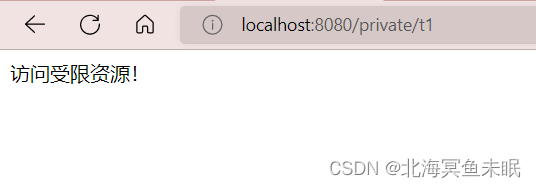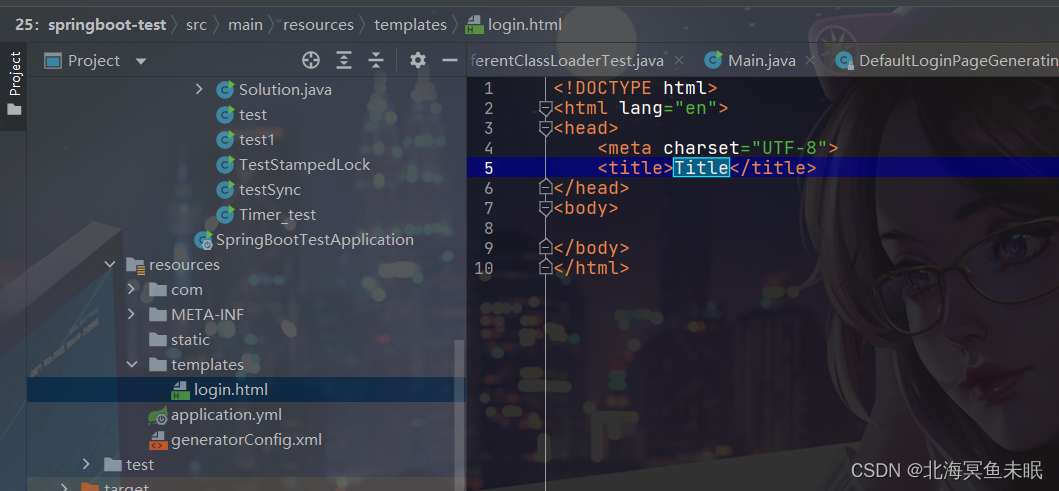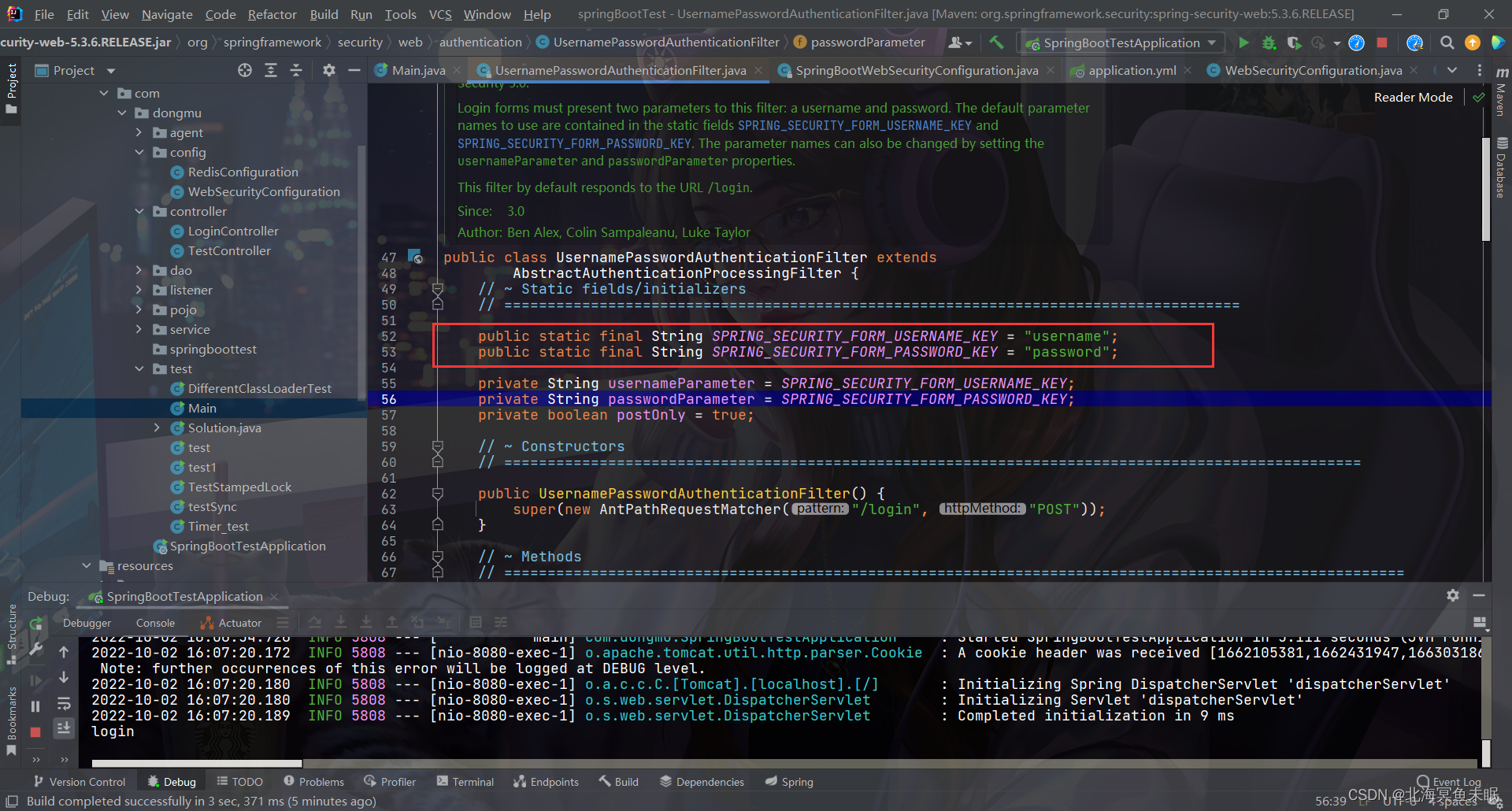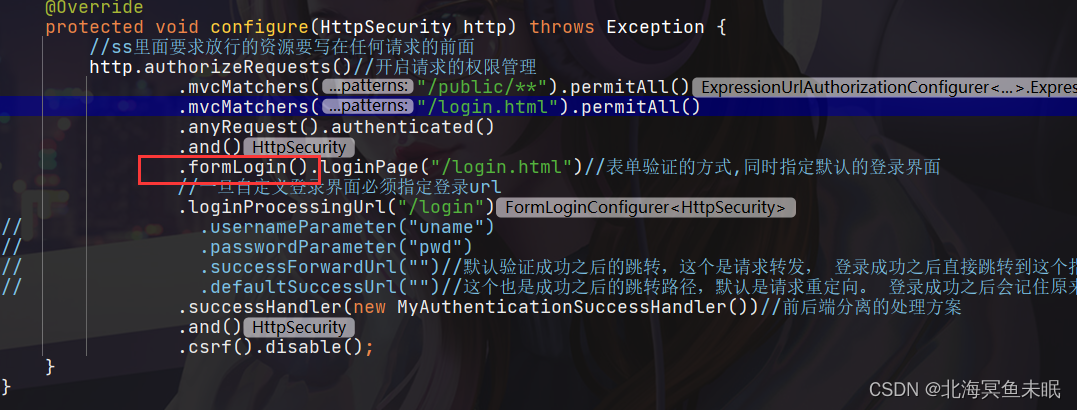由前面的学习可以知道,SS的默认的拦截规则很简单,我们在项目中实际使用的时候往往需要更加复杂的拦截规则,这个时候就需要自定义一些拦截规则。
自定义拦截规则
在我们的项目中,资源往往是需要不同的权限才能操作的,可以分为下面几种:
- 公共资源:可以随意访问
- 认证访问:只有登录了之后的用户才能访问。
- 授权访问:登录的用户必须具有响应的权限才能够访问。
我们想要自定义认证逻辑,就需要创建一些原来不存在的bean,这个时候就可以使@ConditionalOnMissingBean注解发现创建默认的实现类失效。
测试环境搭建
@RequestMapping("/public/test")
public String justatest(){
return "just a test,这个是公共资源!";
}
@RequestMapping("/private/t1")
public String t1(){
return "访问受限资源!";
}
下面我们重写一个配置类去替换内部默认的配置类
@Configuration
public class WebSecurityConfiguration extends WebSecurityConfigurerAdapter {
@Override
protected void configure(HttpSecurity http) throws Exception {
//ss里面要求放行的资源要写在任何请求的前面
http.authorizeRequests()//开启请求的权限管理
.mvcMatchers("/public/**").permitAll()
.anyRequest().authenticated()
.and()
.formLogin();//表单验证的方式
}
}
下面测试,访问公共资源

访问/private/t1跳转到

输入账号密码之后访问到

自定义登录界面
在前面的学习中我们知道了默认的登录界面是在过滤器DefaultLoginPageGeneratingFilter里面实现的,现在我们想要自定义一个登录界面。
- 首先引入thymeleaf依赖
<dependency>
<groupId>org.springframework.boot</groupId>
<artifactId>spring-boot-starter-thymeleaf</artifactId>
</dependency>
- 在templates目录下面创建一个login的html页面

<!DOCTYPE html>
<html lang="en" xmlns:th="http://www.thymeleaf.org">
<head>
<meta charset="UTF-8">
<title>冬木自定义用户登录</title>
</head>
<body>
<form th:action="@{/login}" method="post">
用户名:<input type="text" name="username"><br>
密码:<input type="text" name="password"><br>
<input type="submit" name="登录">
</form>
</body>
</html>
编写一个controller接口用于跳转到我们自己写的登录页面,


这里的前缀默认就是在templates下面因此我下面直接return login
package com.dongmu.controller;
import org.springframework.stereotype.Controller;
import org.springframework.web.bind.annotation.RequestMapping;
@Controller
public class LoginController {
@RequestMapping("/login.html")
public String login(){
return "login";
}
}
添加配置路径,
spring:
thymeleaf:
cache: false #可以让我们的修改立即生效
另外把认证相关的接口放行
@Override
protected void configure(HttpSecurity http) throws Exception {
//ss里面要求放行的资源要写在任何请求的前面
http.authorizeRequests()//开启请求的权限管理
.mvcMatchers("/public/**").permitAll()
.mvcMatchers("/login.html").permitAll()
.anyRequest().authenticated()
.and()
.formLogin().loginPage("/login");//表单验证的方式,同时指定默认的登录界面
}
这个时候再去访问页面就会跳转到下面这个页面

这个时候登录会发现还是条状到登录页面,这里要注意,一旦指自定义了登录页面就需要指定登录的url,所以我们在接口里面添加下面的代码
//ss里面要求放行的资源要写在任何请求的前面
http.authorizeRequests()//开启请求的权限管理
.mvcMatchers("/public/**").permitAll()
.mvcMatchers("/login.html").permitAll()
.anyRequest().authenticated()
.and()
.formLogin().loginPage("/login.html")//表单验证的方式,同时指定默认的登录界面
//一旦自定义登录界面必须指定登录url
.loginProcessingUrl("/login")
.and()
.csrf().disable();
这个时候就可以登录成功了。
但是这时候要注意源码中指定了登录的参数名,只能是username和password。

这个时候可以进行修改如下
http.authorizeRequests()//开启请求的权限管理
.mvcMatchers("/public/**").permitAll()
.mvcMatchers("/login.html").permitAll()
.anyRequest().authenticated()
.and()
.formLogin().loginPage("/login.html")//表单验证的方式,同时指定默认的登录界面
//一旦自定义登录界面必须指定登录url
.loginProcessingUrl("/login")
.usernameParameter("uname")//指定登录的参数
.passwordParameter("pwd")
// .successForwardUrl("")//默认验证成功之后的跳转,这个是请求转发, 登录成功之后
//直接跳转到这个指定的地址,原来的地址不跳转了。
.defaultSuccessUrl("")//这个也是成功之后的跳转路径,默认是请求重定向。 登录成功之
//后会记住原来访问的路径,也可以再传递一个boolean参数指定地址默认false
.and()
.csrf().disable();
前后端分离项目路径跳转
前面介绍了前后端不分离项目的登录认证成功之后的路径跳转,但是针对于前后端分离项目,比如有的时候可能会发送AJAX请求,这个时候怎么处理呢?

我们可以自定义一个类实现AuthenticationSuccessHandler接口即可。
package com.dongmu.config;
import com.fasterxml.jackson.databind.ObjectMapper;
import org.springframework.security.core.Authentication;
import org.springframework.security.web.authentication.AuthenticationSuccessHandler;
import javax.servlet.ServletException;
import javax.servlet.http.HttpServletRequest;
import javax.servlet.http.HttpServletResponse;
import java.io.IOException;
import java.util.HashMap;
public class MyAuthenticationSuccessHandler implements AuthenticationSuccessHandler {
@Override
public void onAuthenticationSuccess(HttpServletRequest request, HttpServletResponse response, Authentication authentication) throws IOException, ServletException {
HashMap<String,Object> hashMap = new HashMap<>();
hashMap.put("msg","登录成功");
hashMap.put("code",200);
hashMap.put("auth",authentication);
response.setContentType("application/json;charset=utf-8");
String s = new ObjectMapper().writeValueAsString(hashMap);
response.getWriter().write(s);
}
}
在successHandler里面配置即可
//ss里面要求放行的资源要写在任何请求的前面
http.authorizeRequests()//开启请求的权限管理
.mvcMatchers("/public/**").permitAll()
.mvcMatchers("/login.html").permitAll()
.anyRequest().authenticated()
.and()
.formLogin().loginPage("/login.html")//表单验证的方式,同时指定默认的登录界面
//一旦自定义登录界面必须指定登录url
.loginProcessingUrl("/login")
// .usernameParameter("uname")
// .passwordParameter("pwd")
// .successForwardUrl("")//默认验证成功之后的跳转,这个是请求转发, 登录成功之后直接跳转到这个指定的地址,原来的地址不跳转了。
// .defaultSuccessUrl("")//这个也是成功之后的跳转路径,默认是请求重定向。 登录成功之后会记住原来访问的路径
.successHandler(new MyAuthenticationSuccessHandler())//前后端分离的处理方案
.and()
.csrf().disable();
这个时候登录成功返回的是一个json字符串。

身份验证失败跳转
首先点进



UsernamePasswordAuthenticationFilter这个类里面由一个方法attemptAuthentication进行身份的验证
public Authentication attemptAuthentication(HttpServletRequest request,
HttpServletResponse response) throws AuthenticationException {
if (postOnly && !request.getMethod().equals("POST")) {
throw new AuthenticationServiceException(
"Authentication method not supported: " + request.getMethod());
}
String username = obtainUsername(request);
String password = obtainPassword(request);
if (username == null) {
username = "";
}
if (password == null) {
password = "";
}
username = username.trim();
UsernamePasswordAuthenticationToken authRequest = new UsernamePasswordAuthenticationToken(
username, password);
// Allow subclasses to set the "details" property
setDetails(request, authRequest);
return this.getAuthenticationManager().authenticate(authRequest);
}
然后最后一句代码authenticate(authRequest)会进入
public Authentication authenticate(Authentication authentication)
throws AuthenticationException {
Class<? extends Authentication> toTest = authentication.getClass();
AuthenticationException lastException = null;
AuthenticationException parentException = null;
Authentication result = null;
Authentication parentResult = null;
boolean debug = logger.isDebugEnabled();
for (AuthenticationProvider provider : getProviders()) {
if (!provider.supports(toTest)) {
continue;
}
if (debug) {
logger.debug("Authentication attempt using "
+ provider.getClass().getName());
}
try {
result = provider.authenticate(authentication);
if (result != null) {
copyDetails(authentication, result);
break;
}
}
catch (AccountStatusException | InternalAuthenticationServiceException e) {
prepareException(e, authentication);
// SEC-546: Avoid polling additional providers if auth failure is due to
// invalid account status
throw e;
} catch (AuthenticationException e) {
lastException = e;
}
}
if (result == null && parent != null) {
// Allow the parent to try.
try {
result = parentResult = parent.authenticate(authentication);
}
catch (ProviderNotFoundException e) {
// ignore as we will throw below if no other exception occurred prior to
// calling parent and the parent
// may throw ProviderNotFound even though a provider in the child already
// handled the request
}
catch (AuthenticationException e) {
lastException = parentException = e;
}
}
if (result != null) {
if (eraseCredentialsAfterAuthentication
&& (result instanceof CredentialsContainer)) {
// Authentication is complete. Remove credentials and other secret data
// from authentication
((CredentialsContainer) result).eraseCredentials();
}
// If the parent AuthenticationManager was attempted and successful then it will publish an AuthenticationSuccessEvent
// This check prevents a duplicate AuthenticationSuccessEvent if the parent AuthenticationManager already published it
if (parentResult == null) {
eventPublisher.publishAuthenticationSuccess(result);
}
return result;
}
// Parent was null, or didn't authenticate (or throw an exception).
if (lastException == null) {
lastException = new ProviderNotFoundException(messages.getMessage(
"ProviderManager.providerNotFound",
new Object[] { toTest.getName() },
"No AuthenticationProvider found for {0}"));
}
// If the parent AuthenticationManager was attempted and failed then it will publish an AbstractAuthenticationFailureEvent
// This check prevents a duplicate AbstractAuthenticationFailureEvent if the parent AuthenticationManager already published it
if (parentException == null) {
prepareException(lastException, authentication);
}
throw lastException;
}
上面代码中
try {
result = provider.authenticate(authentication);
if (result != null) {
copyDetails(authentication, result);
break;
}
}
这一块会进入
public Authentication authenticate(Authentication authentication)
throws AuthenticationException {
Assert.isInstanceOf(UsernamePasswordAuthenticationToken.class, authentication,
() -> messages.getMessage(
"AbstractUserDetailsAuthenticationProvider.onlySupports",
"Only UsernamePasswordAuthenticationToken is supported"));
// Determine username
String username = (authentication.getPrincipal() == null) ? "NONE_PROVIDED"
: authentication.getName();
boolean cacheWasUsed = true;
UserDetails user = this.userCache.getUserFromCache(username);
if (user == null) {
cacheWasUsed = false;
try {
user = retrieveUser(username,
(UsernamePasswordAuthenticationToken) authentication);
}
这里面user = retrieveUser(username, (UsernamePasswordAuthenticationToken) authentication);的实现
protected final UserDetails retrieveUser(String username,
UsernamePasswordAuthenticationToken authentication)
throws AuthenticationException {
prepareTimingAttackProtection();
try {
UserDetails loadedUser = this.getUserDetailsService().loadUserByUsername(username);
if (loadedUser == null) {
throw new InternalAuthenticationServiceException(
"UserDetailsService returned null, which is an interface contract violation");
}
return loadedUser;
}
catch (UsernameNotFoundException ex) {
mitigateAgainstTimingAttack(authentication);
throw ex;
}
catch (InternalAuthenticationServiceException ex) {
throw ex;
}
catch (Exception ex) {
throw new InternalAuthenticationServiceException(ex.getMessage(), ex);
}
}
可以发现这里就是去一开始我们学习的map里面找到对应用户名和密码,这里面应该会报出异常。这个异常后面会被这个方法接收
private void doAuthenticate(HttpServletRequest request, HttpServletResponse response) throws IOException, ServletException {
Authentication authResult;
Object principal = getPreAuthenticatedPrincipal(request);
Object credentials = getPreAuthenticatedCredentials(request);
if (principal == null) {
if (logger.isDebugEnabled()) {
logger.debug("No pre-authenticated principal found in request");
}
return;
}
if (logger.isDebugEnabled()) {
logger.debug("preAuthenticatedPrincipal = " + principal
+ ", trying to authenticate");
}
try {
PreAuthenticatedAuthenticationToken authRequest = new PreAuthenticatedAuthenticationToken(
principal, credentials);
authRequest.setDetails(authenticationDetailsSource.buildDetails(request));
authResult = authenticationManager.authenticate(authRequest);
successfulAuthentication(request, response, authResult);
}
catch (AuthenticationException failed) {
unsuccessfulAuthentication(request, response, failed);
if (!continueFilterChainOnUnsuccessfulAuthentication) {
throw failed;
}
}
}
执行unsuccessfulAuthentication
protected void unsuccessfulAuthentication(HttpServletRequest request,
HttpServletResponse response, AuthenticationException failed) throws IOException, ServletException {
SecurityContextHolder.clearContext();
if (logger.isDebugEnabled()) {
logger.debug("Cleared security context due to exception", failed);
}
//这里会把异常信息放到request作用域当中
request.setAttribute(WebAttributes.AUTHENTICATION_EXCEPTION, failed);
if (authenticationFailureHandler != null) {
authenticationFailureHandler.onAuthenticationFailure(request, response, failed);
}
}
这里配置请求转发
protected void configure(HttpSecurity http) throws Exception {
//ss里面要求放行的资源要写在任何请求的前面
http.authorizeRequests()//开启请求的权限管理
.mvcMatchers("/public/**").permitAll()
.mvcMatchers("/login.html").permitAll()
.anyRequest().authenticated()
.and()
.formLogin().loginPage("/login.html")//表单验证的方式,同时指定默认的登录界面
//一旦自定义登录界面必须指定登录url
.loginProcessingUrl("/login")
// .usernameParameter("uname")
// .passwordParameter("pwd")
// .successForwardUrl("")//默认验证成功之后的跳转,这个是请求转发, 登录成功之后直接跳转到这个指定的地址,原来的地址不跳转了。
// .defaultSuccessUrl("")//这个也是成功之后的跳转路径,默认是请求重定向。 登录成功之后会记住原来访问的路径
.successHandler(new MyAuthenticationSuccessHandler())//前后端分离的处理方案
.failureForwardUrl("/login.html")//登录失败之后的请求转发页面
// .failureUrl("/login.html")//登录失败之后的重定向页面
.and()
.csrf().disable();
}
可以直接从request作用域中获取异常
<!DOCTYPE html>
<html lang="en" xmlns:th="http://www.thymeleaf.org">
<head>
<meta charset="UTF-8">
<title>冬木自定义用户登录</title>
</head>
<h2>
<div th:text="${SPRING_SECURITY_LAST_EXCEPTION}"></div>
</h2>
<body>
<form th:action="@{/login}" method="post">
用户名:<input type="text" name="username"><br>
密码:<input type="text" name="password"><br>
<input type="submit" name="登录">
</form>
</body>
</html>

如果是在重定向就会放在session作用域中。如果是请求转发就会放到reques作用域中。
前后端分离项目认证失败处理
实现接口AuthenticationFailureHandler
package com.dongmu.config;
import com.fasterxml.jackson.databind.ObjectMapper;
import org.springframework.security.core.Authentication;
import org.springframework.security.core.AuthenticationException;
import org.springframework.security.web.authentication.AuthenticationFailureHandler;
import org.springframework.security.web.authentication.AuthenticationSuccessHandler;
import javax.servlet.ServletException;
import javax.servlet.http.HttpServletRequest;
import javax.servlet.http.HttpServletResponse;
import java.io.IOException;
import java.util.HashMap;
public class MyAuthenticationHandler implements AuthenticationSuccessHandler, AuthenticationFailureHandler {
@Override
public void onAuthenticationSuccess(HttpServletRequest request, HttpServletResponse response, Authentication authentication) throws IOException, ServletException {
HashMap<String,Object> hashMap = new HashMap<>();
hashMap.put("msg","登录成功");
hashMap.put("code",200);
hashMap.put("auth",authentication);
response.setContentType("application/json;charset=utf-8");
String s = new ObjectMapper().writeValueAsString(hashMap);
response.getWriter().write(s);
}
@Override
public void onAuthenticationFailure(HttpServletRequest request, HttpServletResponse response, AuthenticationException exception) throws IOException, ServletException {
HashMap<String,Object> hashMap = new HashMap<>();
hashMap.put("code",403);
hashMap.put("msg",exception.getMessage());
response.setContentType("application/json;charset=utf-8");
String s = new ObjectMapper().writeValueAsString(hashMap);
response.getWriter().write(s);
}
}
配置认证失败接口实现类
protected void configure(HttpSecurity http) throws Exception {
//ss里面要求放行的资源要写在任何请求的前面
http.authorizeRequests()//开启请求的权限管理
.mvcMatchers("/public/**").permitAll()
.mvcMatchers("/login.html").permitAll()
.anyRequest().authenticated()
.and()
.formLogin().loginPage("/login.html")//表单验证的方式,同时指定默认的登录界面
//一旦自定义登录界面必须指定登录url
.loginProcessingUrl("/login")
// .usernameParameter("uname")
// .passwordParameter("pwd")
// .successForwardUrl("")//默认验证成功之后的跳转,这个是请求转发, 登录成功之后直接跳转到这个指定的地址,原来的地址不跳转了。
// .defaultSuccessUrl("")//这个也是成功之后的跳转路径,默认是请求重定向。 登录成功之后会记住原来访问的路径
// .successHandler(new MyAuthenticationSuccessHandler())//前后端分离的处理方案
// .failureForwardUrl("/login.html")//登录失败之后的请求转发页面
.failureUrl("/login.html")//登录失败之后的重定向页面
.failureHandler(new MyAuthenticationHandler())
.and()
.csrf().disable();
}
























 1万+
1万+











 被折叠的 条评论
为什么被折叠?
被折叠的 条评论
为什么被折叠?










